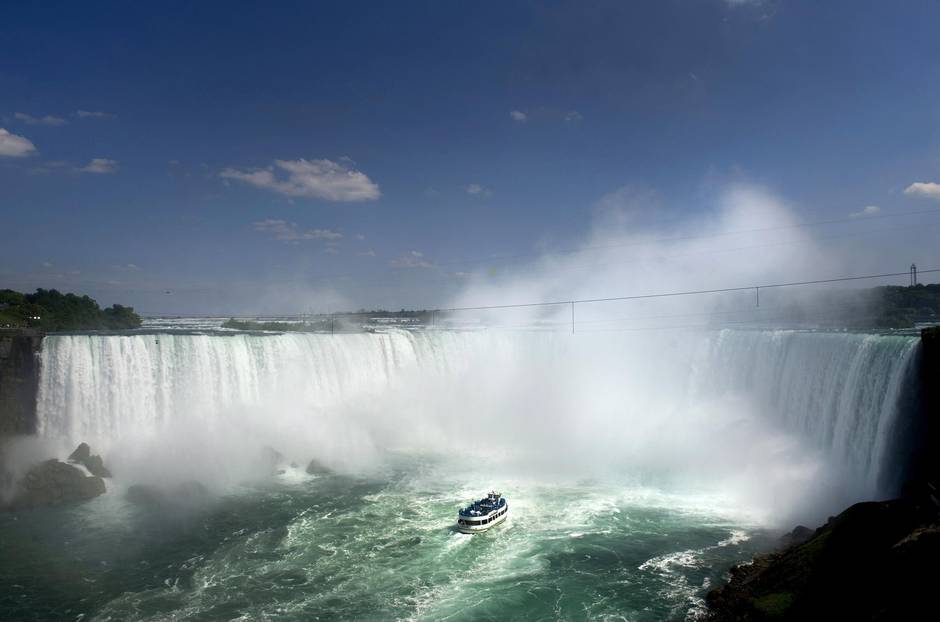The Story of the Niagara River: The Water Wonder of the World

Oscar Wilde, Richard Nixon, Pierre Trudeau, Marilyn Monroe, Winston Churchill, Shirley Temple, Abraham Lincoln, Mark Twain, Charles Blondin, Wild Bill Hickok, Laura Secord, H.G. Wells, Charles Dickens, Helen Keller, Sir Harry Oakes, Jimmy Stewart, Princess Diana …
Bit characters all – in a story in which the main character has always been and will always be: the Falls.
Those famous names, with one notable exception, were all as impressed in their day by Niagara Falls as will be the millions of visitors who come this year to stare in awe at one of the Seven Natural Wonders of the World.
Helen Keller, who could not see and could not hear, experienced the falls through her hands. She was so moved by the vibrations she could feel on a hotel windowsill that she told her mother: “One feels helpless and overwhelmed in the presence of such a vast force.”
“Endless water falling the wrong way,” sniffed Oscar Wilde when he visited in late winter of 1882. The legendary Irish wit is also said to have claimed that the legendary honeymoon destination “must be a bride’s second-greatest disappointment.”
There is no disappointment, however, on this recent day, with the sun painting rainbows in the mist over the Canadian-side Horseshoe Falls. Hundreds of viewers line the walkway that runs alongside. Buses discharge tourists who have flown to Canada from China, mostly young couples with selfie sticks to capture themselves in various romantic poses with the falls as backdrop.
Two young friends have driven down from Toronto for the day. Alejandro Mena, 21, has come from Colombia to see what he calls “one of the five wonders of the world.”
“Seven!” corrects his pal, 23-year-old Bruno Dutey from Spain.
“Okay, seven,” concedes Mr. Mena, who adds that he has found the falls to be a bit of an optical illusion, as they’ve been walking for some time now without seeming to get any closer.
“The closer you get to it,” Mr. Dutey says, “the greater it gets.”
In fact, they have no idea how truly great. The white water that roars over the falls before them may be moving in excess of 100 kilometres an hour. All the mind-boggling numbers that can be placed before cubic feet and gallons might be better illustrated by the writer who calculated there was the equivalent of one million bathtubs full of water going over the falls every single second.
But still, impressive as that sounds, it is still only half of what once was.

In late 1678, Father Louis Hennepin, claimed by some to be the first European to see the falls – others say Étienne Brûlé had been there a half-century earlier – declared that “the Universe does not hold its parallel.”
Hennepin also found the noise “outrageous … more terrible than that of thunder.”
There is something about Niagara and hyperbole. According to local historian Sherman Zavitz’s It Happened At Niagara, when a young Abraham Lincoln first visited the falls, the future president pronounced: “When Columbus first sought this continent – when Christ suffered on the cross – when Moses led Israel through the Red Sea – nay, even, when Adam first came from the hand of his maker – then, as now, Niagara was roaring here.”
“Then, as now” being 1848 – but not these days.
For one thing, the falls have moved, a remarkable recession chartered by scientists to have shifted 11 km upstream in the past 12,000 years. Every year, more breaks away, sometimes rock chunks the size of a sixteen-wheeler.
“The shape of the falls is always changing,” says Environment Canada’s Aaron Thompson, who also serves as chair of the International Niagara Board of Control. “The rate has slowed down because so much of the flow goes to the power plants.”
And this, it turns out, is what separates the falls the tourists photograph today from the falls that First Nations knew, which so impressed the likes of Hennepin and Lincoln.
The power of Niagara was such that it created the first great industrial centre of North America. By diverting the water into tunnels leading to turbines, industrialists were able to create electricity, first of all direct-current. Once Nikola Tesla invented alternating-current – a discovery Thomas Edison campaigned against as being too dangerous – it allowed for electricity to travel distances and the great industrialization of the Niagara region spread.
Increasingly, more and more water was diverted into such tunnels. Lord Kelvin, the famous Irish inventor and engineer, said he looked forward to the day when every single drop in the river would be used to create electricity.
Fortunately, wiser heads prevailed. One early suggestion had the power companies ransacking the Niagara as much as they wished six days a week but doing nothing on Sundays so that the tourists could enjoy the falls. That idea, luckily, went nowhere. In 1950, the Niagara Diversion Treaty signed by Canada and the United States specified how much each country could draw for power – roughly half the flow that Hennepin and Lincoln had witnessed.
“They could see that one day there would be no water going over the falls,” Mr. Thompson. says
Today, the flow and diversion gates are all computer-controlled and monitored. Less water is diverted during night hours and during winter. Intricate steel booms are placed each year at the Lake Erie mouth so that ice can be relatively controlled.
“We try to keep the ice on at Lake Erie as long as possible so it doesn’t come in and play havoc with the flow,” says Mr. Thompson.
In late January, a public hearing was held to discuss a proposal to “de-water” the American Falls. Two 150-year-old bridges connecting to islands upstream from the falls are in dire need of repair or replacement.
The idea is to divert the water so that it flows only on the Canadian side of Goat Island and over the Horseshoe Falls, theoretically restoring the Canadian falls to the size they were when Hennepin thought the universe held no parallel.
The American side has gone dry, or fairly dry, before, once in 1842 when a massive ice jam briefly plugged the entry point of the river at Lake Erie, and again in 1969 when U.S. army engineers thought they could clean up the American side and perhaps even improve its look.
This new proposal could see the American Falls “de-watered” for as long as it takes to complete the work on the two bridges.
Incredibly, there are those who are hoping the longer the better. They are convinced it would even be great for tourism.
There is already talk of T-shirts and bumper stickers: “I was there when Niagara Falls ran dry.”

The price of progress
The Niagara River could be described as the most important shortest river in the world – except it isn’t truly a river. It’s a 58-km-long strait, or “connecting channel,” that runs north from Lake Erie and empties into Lake Ontario. Political junkies well recall Canadian Alliance Leader Stockwell Day’s faux pas during the 2000 federal election campaign when, using the falls as a photo backdrop, he declared that “just as Lake Erie drains from north to south, there is an ongoing drain in terms of our young people” to the U.S.
Informed by a CBC reporter that he had his geography wrong, Mr. Day announced that he would have his people “check the record” – though all he really had to do was check the falls behind him.
Those who live along its path know its short course intimately – but few as well as Patrick Robson. The first hint of Mr. Robson’s devotion is on his licence plate – “1812” – for it was on both sides of this river that the only war was ever fought between Canada and the United States.
A former commissioner of planning for the Niagara Region who now works in administration at Niagara College, Mr. Robson has lived his entire life in the region. He believes the river, falls and surrounding countryside is endlessly fascinating – a story of war, peace, power, industry, tourism, pollution and, fingers crossed, solution.
“It’s about people and identity,” he says. “Niagara Peninsula is packed with stories – and I have a passion for the stories.”
He is driving along the Niagara Parkway, a relaxing drive along the Canadian side of the river that runs through War of 1812 battlefields, vineyards, farms, small towns and seemingly endless parkland. Winston Churchill called it “the prettiest Sunday afternoon drive in the world.”
Mr. Robson points out Navy Island, a large uninhabited Canadian island that was once home to the brief “Republic of Canada,” a wild idea of Canadian revolutionary William Lyon Mackenzie. Mackenzie amassed 1,000 armed men here in 1837 and would have invaded Canada had British troops not burned his supply ship and American police not arrested him. He was later sent to Ottawa as a member of Parliament, but that, obviously, is quite another story. Navy Island was oncethe popular choice for the United Nations headquarters. American and Canadian supporters argued that it stood as the perfect symbol for two countries that had existed peacefully for more than a century. President Harry Truman was all for it until the rich and powerful stepped in and offered free prime land in New York. Today the island is a wildlife reserve.
Mr. Robson is among several area movers and shakers keen to turn the Niagara region on both sides of the river into an International Peace Park. The long-standing peace between the two countries is a main factor, obviously, but there are other arguments, as well. It is estimated as many as 75,000 fugitive slaves made their way to the Canadian colonies before the American Civil War. The “Niagara Movement” was an early civil-rights force founded in Niagara Falls in 1905. Across the river in Lewiston, N.Y., a “Freedom Crossing” monument points over the water to sanctuary.
A few minutes down the Parkway, the crowning mist of Horseshoe Falls is visible in the distance. Even though he lives nearby, a trip to the falls is a rare event for Mr. Robson.
“I don’t go down to the falls often,” he says. “I know what happens there. We tend to forget there are a whole host of other things going on here just off the beaten track.”
He prefers the historical sites such as Lundy’s Lane, Laura Secord’s homestead, the many battlegrounds of the war – most of the fighting, killing, burning and ransacking took place along the forts and villages of the peninsula.

The falls of today is more about duelling casinos on both sides of the border, tourism and such curious attractions as the “genuine two-headed lamb” at Ripley’s Believe It or Not! museum.
Mr. Robson is no fan of the casinos – “gamblers aren’t tourists” – but he does have a soft spot for the great daredevils who once made the falls as famous for stunts as they are for size.
Though an estimated half-billion television viewers tuned in on June 15, 2012, to watch Nik Wallenda walk across a cable strung over the Horseshoe Falls, Mr. Robson’s affection is for the great stuntmen of the mid-19th century. In the summer of 1860, Frenchman Charles Blondin and The Great Farini (William Leonard Hunt of Port Hope, Ont.) challenged each other to the point of absurdity – and tragedy.
Farini crossed on a tightrope while wearing peach baskets on his feet. Blondin at one point carried a stove on his back, stopped halfway across, cooked an omelette and lowered it down to The Maid of the Mist, where passengers eagerly ate it. Farini matched by carrying a washtub out, lowering a bucket into the river, then washing handkerchiefs that had been given to him by his many female admirers. Farini also carried a woman across on his back but slipped and dropped her to her death.
No one knows the total of those who died by accident or design at the falls. Many bodies are never found. After a 63-year-old teacher named Annie Edson Taylor survived going over in a barrel in 1901, barrel attempts became popular though rarely successful. The wilder stunts were long ago banned by the authorities, yet some persist, such as the nut who blew over the falls on a jet ski several years back only to have his parachute fail to open.
There are happy endings, most notably seven-year-old Roger Woodward surviving a plunge over the falls without even a barrel in 1960, but they are few and far between. The tragedies, both foolish and accidental, far outweigh the victories.
Niagara Falls is no longer the setting for serial stunts such as Blondin vs. Farini. Hydro-electric power arrived in the late 19th century, then vast and polluting industry throughout much of the 20th century. Slowly, that heavy industry vanished or moved on, leading to a slow and difficult awareness of the damage “progress” had done to one of the Seven Natural Wonders of the World.
“It’s an economy in transition,” Mr. Robson says. “It’s gone from a heavy industrial economy, one of the first industrial areas of North America, to what it is today – all because of one thing, falling water.”

Celebrating the wetlands
It is early Monday morning for the students of Brock University in St. Catharines, Ont. Geography class began at 8 a.m. and those students not staring at their mobile phones or laptop computers are slowly awakening to the day.
Jocelyn Baker and Deanna Lindblad of the Niagara Peninsula Conservation Authority have come to talk about water. If you could track a single drop, the students are told, it would take 204 years for that water to travel from Thunder Bay to the mouth of the St. Lawrence. Crossing Lake Superior alone would take 174 years, but only 2 1/2 years for Lake Erie and a matter of hours to run the Niagara River, over the falls and into Lake Ontario.
Increasingly, the students seem to be paying attention. The Great Lakes, they are told, contain 22 per cent of the world’s freshwater. One out of every three Canadians relies on this source for drinking water. The British newspaper The Guardian says that now four billion people face severe water shortages for at least one month of the year, with drought a rising concern over vast swaths of the earth. Canadians are among the very lucky.
That water, travelling so easily and quickly through the Niagara River, is what made places like St. Catharines possible. Electricity powered industries, which built economies. Buffalo, often so dismissed these days, was known as “The City of Lights” in the early 1900s. According to Kevin Woyce’s illustrated history of Niagara, the Pan American Exposition of 1901 drew eight million visitors, most coming to stare in wonder at Electric Tower, a 100-metre monolith lighted by 44,000 bulbs.
Everything seemed possible back then. President William McKinley came and asked the crowd, “Who can tell the new thoughts that have been awakened, the ambition fired and the high achievement that will be wrought through this exhibition?” The next day he was shot by an anarchist, died eight days later and Theodore Roosevelt was sworn in at the home of a local lawyer.
McKinley, however, was proved right. Buffalo became a major industrial city featuring everything from General Mills to Pierce-Arrow cars. One new cereal factory was so fancy that a 1914 tourism brochure boasted “One might as well see Rome without seeing St. Peter’s as to see Niagara Falls without visiting ‘The Home of Shredded Wheat.’”
But at what cost was such massive industrialization along the waters? Science fiction writer H.G. Wells wrote a 1906 magazine article in which he predicted “The End of Niagara.” The spectacular natural site, he said, was “long since destroyed beyond recovery by the hotels, the factories, the powerhouses, the bridges and tramways and hoardings [billboards] that rose about it.”
“The first sewage treatment plant on the river was built only in 1936,” says Lynda Schneekloth, a professor at the University of Buffalo’s School of Architecture and Planning. “We used the rivers as sewers for years. And we have tried, together, to take care of these waters once it became clear how badly we had treated them.”
By the 1970s, there were more than 700 chemical plants and steel mills dotting the Niagara River waterway. Each day, some 950 million litres of waste water were being washed away by the river.
Some steps were eventually taken to address the growing issue of pollution. In 1972, Canada’s Prime Minister Pierre Trudeau and U.S. President Richard Nixon signed the Great Lakes Water Quality Agreement. But it took a singular dramatic story to bring the health concerns to the forefront.
“The Love Canal,” Ms. Baker tells the Brock students. “This was a truly important historical event.”
An entrepreneur named William T. Love had long ago decided to build a canal that would allow him to divert water from the river through the eastern edge of Niagara Falls, N.Y. When financing dried up, he abandoned the project after digging a trench less than two km long. It filled with water and became a swimming hole for local children.
In the late 1940s, the Hooker Chemical Co. purchased the canal and began filling it with barrels of toxic waste which were then buried. By the 1960s, those chemicals had leached free. Children were burning their hands on what they called “firerocks.” Investigative reporters in the 1970s uncovered staggering tales of cancers and birth defects in the area.
“It was the biggest environmental crisis in U.S. history,” Ms. Baker says.
National outrage demanded action and the various levels of government were forced to act. A school that had been built on the property was closed and some 800 families relocated to new homes.
Since that pivotal moment, matters have changed dramatically along the Niagara River. In 1987, this was one of 43 “areas of concern” identified within the Great Lakes Basin. A “Remedial Action Plan” to restore health began and has seen considerable success. Priority was given to 18 toxic pollutants that were targeted for reduction. A recent Brock University study on environmental restoration by engineer Annie Michaud concluded that “the past 25 years have seen a significant improvement in the quality of the Niagara River.”
Those working on the river’s water quality hope to see the Niagara delisted as a “hot spot” by 2020.
The hope, Ms. Lindblad says, is that the Niagara can change from “one of the most polluted, disgusting places on the face of the earth” to a river known for its biodiversity and successes.

“It’s important to celebrate how far we have come,” she says. “And delisting by 2020 doesn’t mean we walk away. There’s always a concern about ‘backsliding.’”
The conservation authority is spearheading a movement to have the Niagara region on both sides of the river declared a Ramsar site of international importance. (“Ramsar” refers to the Iranian city where, in 1971, an international treaty was signed to promote the conservation and wise use of valuable wetlands. Canada alone has 37 such designated sites.)
The river currently meets all criteria for designation and supporters are hopeful to gain it for the sesquicentennial celebrations of 2017 – but there has been some pushback from area politicians and landowners who fear more restrictions could stifle development. One local mayor told an area publication that “the burden of overregulation in Niagara is huge – to me this sounds like another layer.”
The wetlands protection movement has support on the American side, as well. Kerry Mitchell, who spent more than 20 years as a manager and policy expert with the Canadian consulate in Buffalo, says that “a Ramsar designation of the Niagara River would provide the cross-border region its first, ongoing, non-political, inspirationally oriented framework for collaboration” on the river corridor.
A wide consortium of interested stakeholders on both sides of the river has been “Rethinking Niagara” in recent years. The idea, says Prof. Schneekloth, who is part of the group, grew out of the profound change in cross-river exchange that came about following 9/11. The group mapped out all their shared histories, from First Nations to commerce to tourism to water-quality sustainability.
“We took our relationship for granted,” Prof. Schneekloth says of the situation prior to the terrorist attacks. “But now, with so much attention on division, we had to reimagine ourselves as a single place with a shared border.”
Her group, composed of Canadians and Americans, is trusting that either the establishment of an international peace park or the Ramsar designation, both if possible, would leave “a different kind of mark than 9/11.”
The idea, Prof. Schneekloth says, is to remind those who live there just “how special is our home on the Niagara neck of the Great Lakes.”
Mr. Robson, the former planning commissioner, pulling his car into the picturesque town of Niagara-on-the-Lake, where the Niagara River completes its short-but-fascinating run from Lake Erie to Lake Ontario, has known all his life just how special his home is. He’s all for the peace park but isn’t sure a full “reimagining” is necessary.
“People keep saying, ‘We’ve got to do some branding.’” He says. “What for?
“I’m pretty sure if you were to use the word ‘Niagara’ anywhere in the world, they’d know where you meant.”








